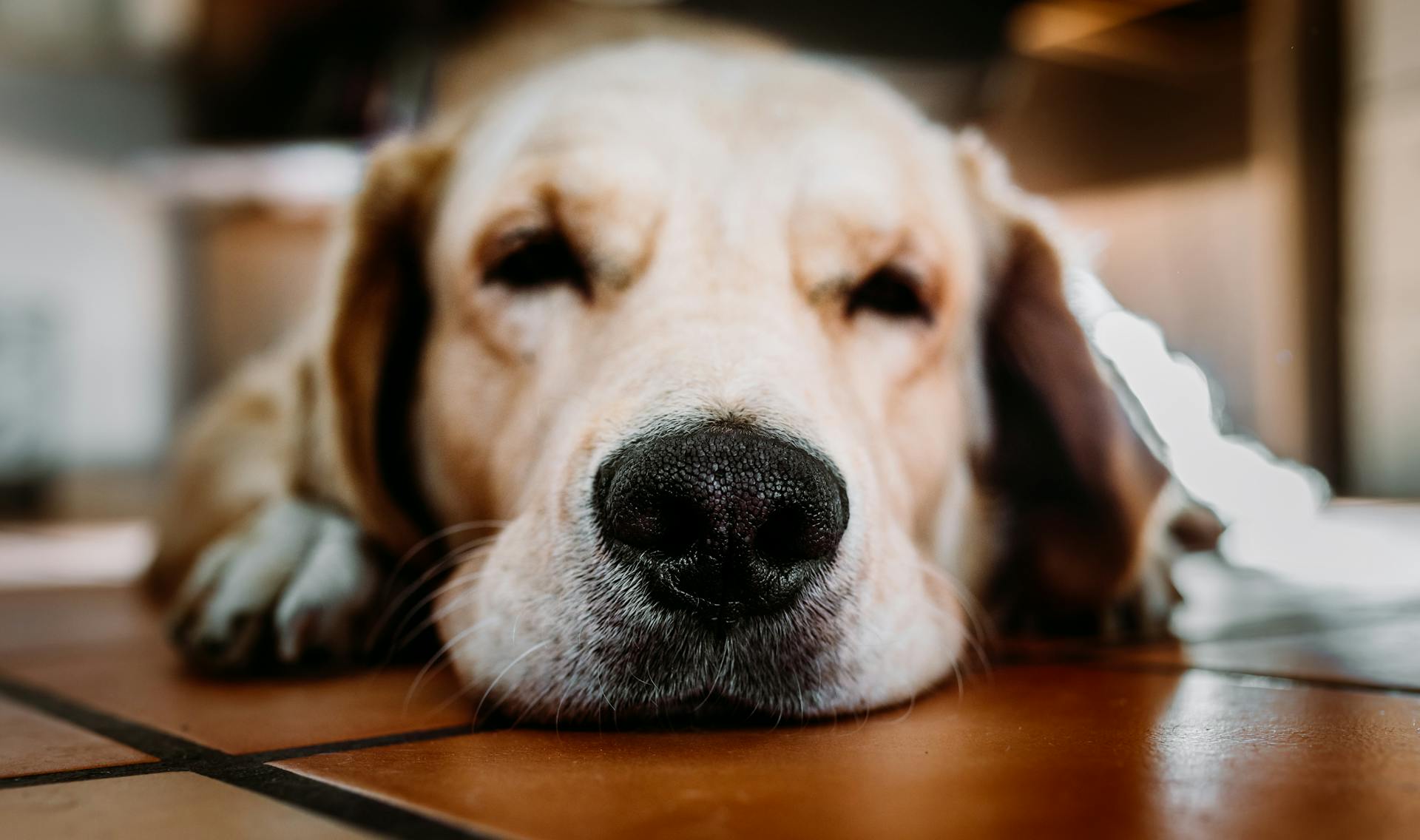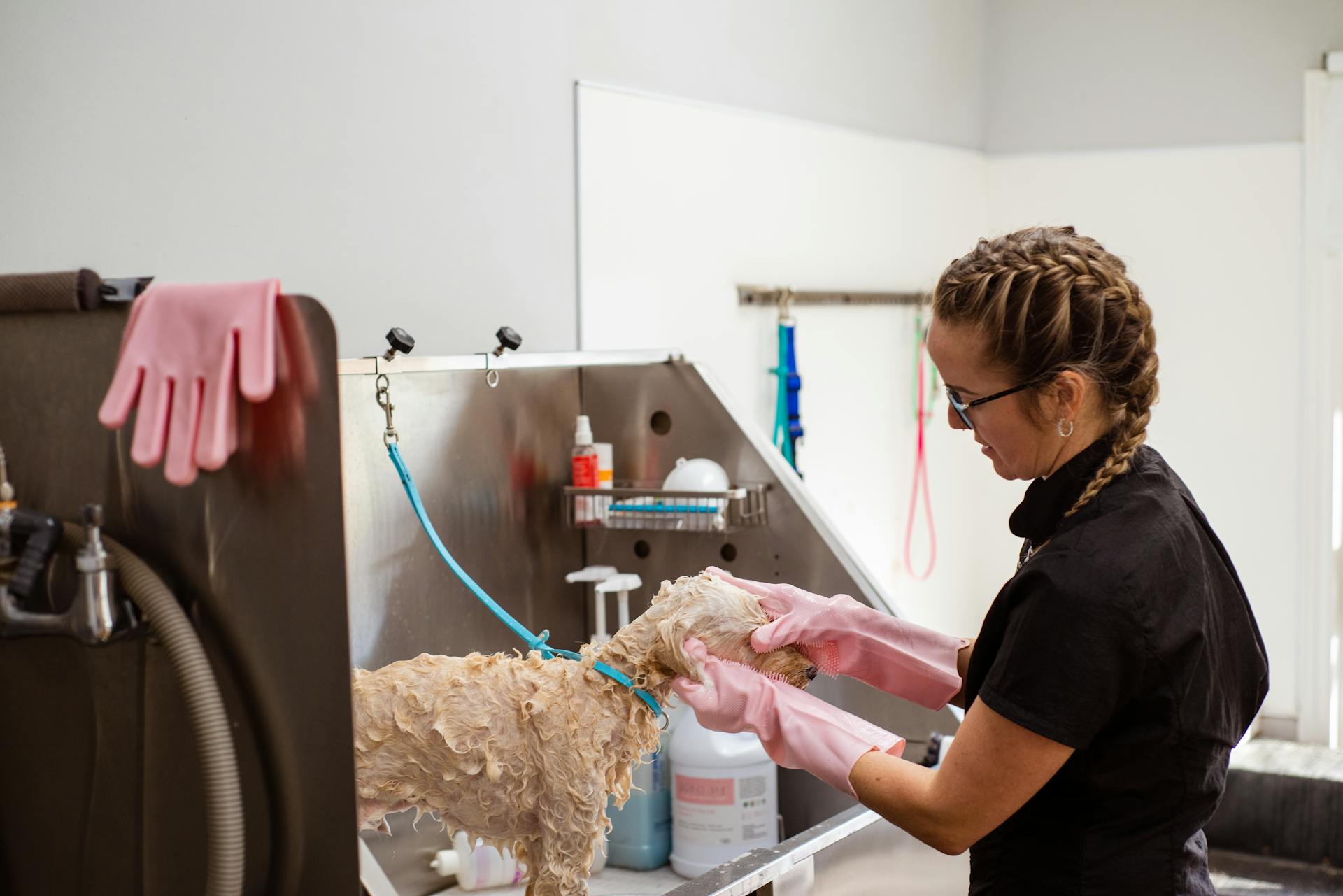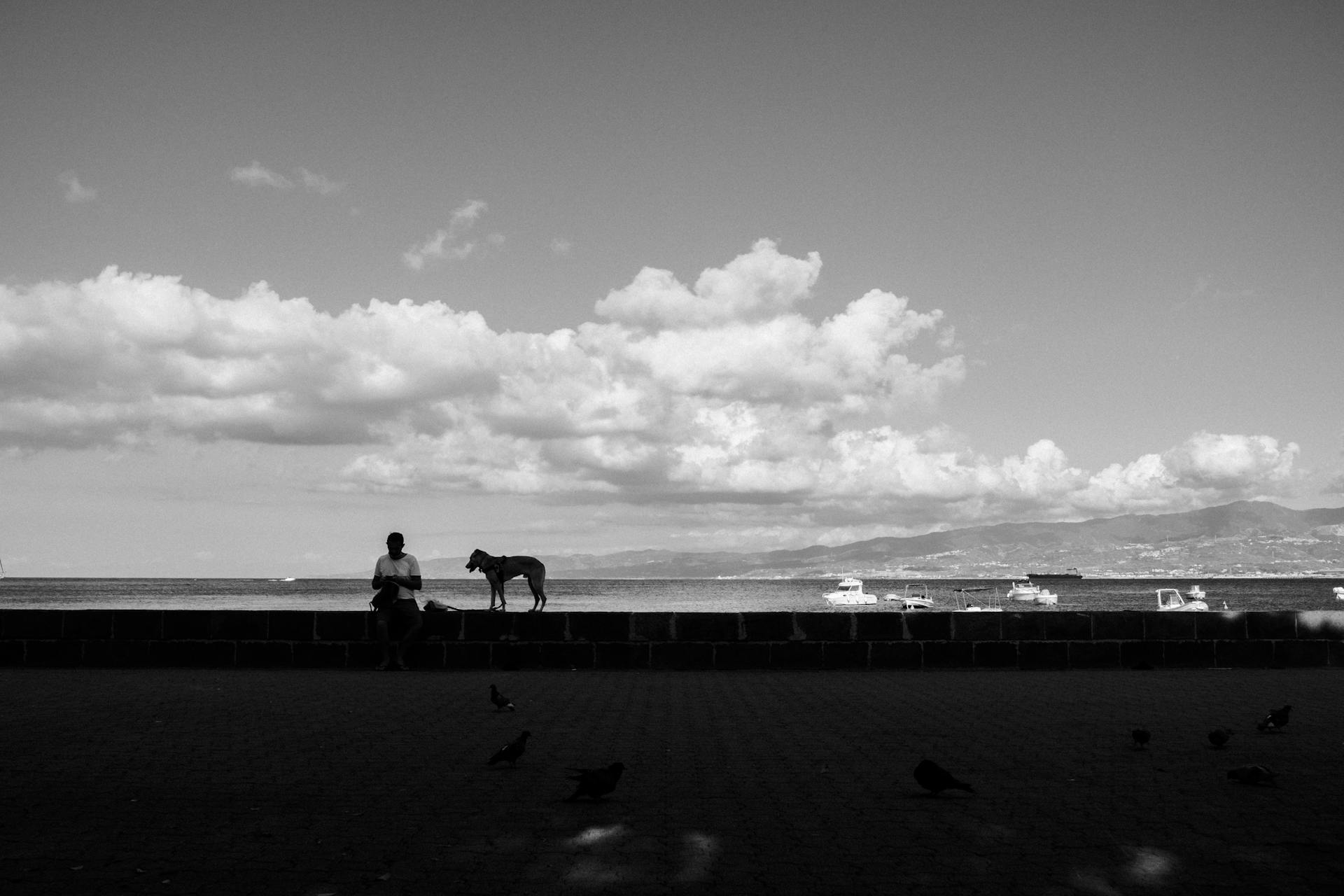
The Chesapeake Bay Retriever is a beloved breed known for its intelligence and athleticism.
They originated from flat-coated retrievers brought over by English sportsmen in the 19th century to hunt waterfowl on Maryland's Eastern Shore.
This breed was specifically bred to withstand harsh weather conditions, with a thick coat that can grow up to 3 inches long.
Physical Characteristics
Chesapeake Bay Retrievers are large and lean dogs with a muscular build. They typically have a shoulder height ranging from 21 to 26 inches.
Their coat is one of their most distinctive features - it's waterproof and comes in a variety of colors including brown, sedge (red-hued), deadgrass (yellow-tan combinations), and any tone of brown. The outer coat is thick, short, and oily while the undercoat is dense and fine with a woolly feel.
Here are some key physical characteristics to keep in mind:
- Ears: Small, floppy, and positioned high on the head.
- Eyes: Medium-large, set wide apart, and varying shades of yellow and amber.
- Nose: Liver or brown colored.
- Coat Length: Double coat with a thick, short outer coat and dense undercoat.
- Coat Color: Ranges from sedge to deadgrass to any tone of brown.
- Tail: Medium-length, thicker at the base and may feather at the tip.
Their striking amber eyes reflect their intellect, while their high-octave bark keeps potential intruders at bay.
Appearance
The Chesapeake Bay Retriever is a stunning breed with a unique appearance that's perfectly suited for its role as a water retriever.
Their eyes are medium-large, set wide apart, and come in varying shades of yellow and amber, reflecting their intelligence. The nose is liver or brown colored, adding to the breed's distinctive features.
The Chesapeake Bay Retriever has a double coat, with the outer coat being thick, short, and oily, while the undercoat is dense and fine with a woolly feel. This combination provides excellent insulation, enabling the Chessie to hunt in various conditions.
Their coat colors range from sedge (red hues) to deadgrass (yellow-tan combinations) to any tone of brown, making them perfectly camouflaged for their role as water retrievers. White may also appear on the breast, belly, toes, or back of the feet, but it must be limited to these areas.
The breed's hindquarters are especially strong and high-set, with the toes webbed for excellent swimming ability. The forelegs should be straight with good bone, adding to the breed's muscular build.
Additional reading: Yellow Flat Coated Retriever
Here are some key features of the Chesapeake Bay Retriever's appearance:
- Eyes: Medium-large, set wide apart, and in varying shades of yellow and amber.
- Nose: Liver or brown colored.
- Coat: Double coat with thick, short, oily outer coat and dense, fine woolly undercoat.
- Coat Color: Ranges from sedge (red hues) to deadgrass (yellow-tan combinations) to any tone of brown.
- Hindquarters: Strong and high-set, with webbed toes for excellent swimming ability.
Their striking coat and muscular build make the Chesapeake Bay Retriever a sight to behold.
Size
The Chesapeake Bay Retriever is a sturdy breed with some impressive physical characteristics.
Male Chesapeake Bay Retrievers typically have a shoulder height ranging from 23 to 26 inches and weigh between 65 to 80 pounds.
Females usually stand 21 to 24 inches tall, making them slightly shorter than their male counterparts.
Exercise
The Chesapeake Bay Retriever is built for endurance and strength, requiring at least 30 minutes of intense daily activity to be happy and content.
You'll need to provide a lot more than just a brisk walk around the block - your Chessie will spend countless hours playing outside, so it's essential to have activities that can match their energy level. Swimming is an excellent way to help your Chessie burn off all their energy, with their webbed feet and waterproof coat making them water dogs.
Apart from outdoor frolic and play, Chessies are also great at dog sport-related activities like hunting retrievals, field trials, rally, flyball, dock diving, agility, and tracking.
Personality and Temperament
The Chesapeake Bay Retriever is a breed that thrives on outdoor adventures and can be your perfect companion for hiking, hunting, or simply playing fetch.
They have a strong bark and powerful physique, which might make strangers take pause, so it's essential to socialize them properly from an early age. This will help them develop into confident adult dogs who are good with kids as long as everyone respects each other's boundaries.
Chessies can be reserved around strangers, but they're affectionate and loyal to their family - sometimes a bit too much so, as they might not want to share their toys or retrieves. They have a high drive to hunt and retrieve, which is great for active families who enjoy the outdoors together.
Their intelligence and independent streak may test the patience of new pet parents, but with consistent training and positive reinforcement, they can become well-behaved companions. It's crucial to correct resource guarding behavior immediately, especially around young children.
On a similar theme: Why Are Labrador Retrievers so Popular
A well-socialized Chessie will be a cheerful and courageous companion who loves having an active job, but is also content to bond with their family through play and enrichment activities. They're exceptional watchdogs due to their vigilant nature, but this can sometimes lead them to pursue what they desire relentlessly - so it's essential to teach them the value of "no" from a young age.
Their strong-mindedness or stubbornness necessitates firm and consistent training from all adults in the household. Positive reinforcement can go a long way, but giving in to their desires even once can result in prolonged retraining efforts.
Dog Care Essentials
To keep your Chesapeake Bay Retriever happy and healthy, regular exercise is a must. At least 20 minutes of intensive work, training, water retrieves, or play, or up to an hour of calm walks are essential.
As country or suburban dogs, Chessies thrive in open spaces rather than city living. They love swimming and it's an excellent addition to their daily exercise routine. Jogging can start after they turn one, but the distance should be limited initially to protect their growing bones and joints.
Puppies have specific exercise needs depending on their age. From 9 weeks to 4 months, puppy kindergarten, playtime in the yard, and short walks are crucial for their development.
You might enjoy: How Much Exercise Do Labrador Retrievers Need
Care
Chesapeake Bay Retrievers thrive in cooler climates but can adapt to warmer regions with regular swimming opportunities.
To maintain their happiness, these dogs require high exercise levels, which transform them into quiet and contented housedogs when met. Providing at least 20 minutes of intensive work or playtime is essential for their well-being.
Puppies have specific exercise needs depending on their age, requiring puppy kindergarten and short walks between 9 weeks to 4 months. Teaching them to swim during this period can be beneficial.
Between 6 months to a year, fetch and play sessions during cooler times of the day are recommended for your growing pup. Jogging can start after they turn one, but initially limit the distance to protect their developing bones and joints.
Training your Chessie with kindness, consistency, and positive reinforcement is crucial, as harsh treatment can lead to stubborn behavior. Using food rewards and praise can be highly effective in shaping their behavior.
Regular grooming and nail trimming are also essential for maintaining your Chesapeake Bay Retriever's movie-star good looks and agreeable disposition. Brushing their coat regularly will help keep them looking their best.
Recommended read: 4 Months Dogo Argentino Puppy
Rescue Groups
Many Chesapeake Bay Retrievers end up in need of adoption or fostering because their owners didn't fully understand the responsibilities involved in owning one.
If you're considering bringing a Chessie into your life, it's essential to consider adopting from a rescue group instead of buying from a breeder. These groups have already done the hard work of rehabilitating and socializing the dogs, making them ready for a loving home.
Some notable rescue groups include:
- American Chesapeake Club Rescue Network
- Chesapeake Bay Retriever Relief and Rescue
- Chesapeake Safe Harbor
- Chesapeake Bay Retriever Relief and Rescue NW
By adopting from a rescue group, you'll not only be giving a loving home to a dog in need but also avoiding the potential pitfalls of owning a Chessie without proper understanding.
Training
Training your Chesapeake Bay Retriever puppy can be challenging, especially for first-time pet parents.
The good news is that they are eager to learn and excel at various dog sports once you get them started with professional training using positive reinforcement. Food is a strong motivator for Chessies, so use it to your advantage!
Chessies can be prone to resource-guarding, so it's essential to train them early on to nip this undesirable behavior in the bud.
To ensure your Chesapeake Bay Retriever grows into a well-mannered and stress-free pet, make sure to socialize them with new people and other dogs from an early age. This can be done by taking them on walks and enrolling them in puppy school where they learn how to play nicely with other puppies.
Historically considered stubborn and difficult to train, many trainers now recommend using consistent, daily obedience training with play time before and after to keep the dog wanting to work with little or no physical discipline required.
Health and Wellness
Chesapeake Bay Retrievers are generally healthy dogs, but like all breeds, they may be susceptible to specific diseases and conditions.
Hip dysplasia is a hereditary condition that can lead to pain and lameness in the rear legs of Chesapeake Bay Retrievers. Responsible breeders test their parents for this condition and avoid breeding dogs with it. Regular exercise and proper care can help manage hip dysplasia, but in severe cases, surgery may be necessary.
Broaden your view: Bernese Mountain Dog Hip Dysplasia
Progressive retinal atrophy (PRA) is a degenerative eye disorder that causes eventual blindness in Chesapeake Bay Retrievers. Regular eye examinations by a veterinary ophthalmologist are crucial to detect PRA early on. Responsible breeders ensure their dogs are free of this disease.
Here are some common health issues that can affect Chesapeake Bay Retrievers:
- Hip Dysplasia
- Progressive Retinal Atrophy (PRA)
- Von Willebrand’s Disease
- Gastric Dilatation-Volvulus (Bloat)
- Epilepsy
- Chondrodysplasia
Regular health checks, responsible breeding practices, and attentive care can help ensure a happy and healthy life for your Chesapeake Bay Retriever.
Grooming
Grooming is a vital part of your Chesapeake Bay Retriever's health and wellness routine. Regular brushing can help remove dead hair and spread skin oils throughout their coat.
The Chessie's coat is designed to be low-maintenance, but it still needs regular attention to stay healthy. A weekly brushing with a rubber curry brush can make a big difference in removing dead hair and keeping their coat shiny.
Chesapeake Bay Retrievers have harsh outer coats and soft undercoats that require thorough brushing at least once a week. During the spring and fall, when they shed heavily, you may need to brush them daily to keep their coat healthy and looking its best.
Their nails also need regular trimming every two to four weeks to avoid discomfort while walking or running. Don't forget to trim those nails!
Brushing your Chessie's teeth daily can help prevent tartar buildup and keep their teeth in top shape. Your vet should do a professional cleaning yearly, but making it a game with dental treats and flavored toothpaste can make the process much more enjoyable for both you and your furry friend.
Health
As a responsible dog owner, it's essential to be aware of the potential health issues that can affect your Chesapeake Bay Retriever.
Hip dysplasia is a common condition in large breed dogs like Chessies, causing pain and lameness in the rear legs. Responsible breeding practices can help detect this condition early on.
Exercise-induced collapse (EIC) is an inherited intolerance to exercise that affects some Chessies, making them uncoordinated and wobbly after strenuous activity. Genetic testing by responsible breeders can help avoid this condition.
Regular eye examinations are crucial for detecting progressive retinal atrophy (PRA), a degenerative eye disorder that causes eventual blindness in Chessies. Reputable breeders ensure their dogs are free of this disease.
Von Willebrand's disease is a blood disorder that affects clotting, causing symptoms like nosebleeds and prolonged bleeding after surgery in some Chessies. While there's no cure, it can be managed through various treatments.
To keep your Chessie healthy, regular health checks with your veterinarian are essential, especially for conditions like gastric dilatation-volvulus (bloat) that require immediate attention.
Here are some common health issues affecting Chesapeake Bay Retrievers:
- Hip dysplasia
- Progressive retinal atrophy (PRA)
- Von Willebrand's disease
- Gastric dilatation-volvulus (bloat)
- Epilepsy
- Chondrodysplasia
- Follicular dysplasia alopecia
- Degenerative myelopathy (DM)
- Von Willebrand's disease (vWD)
- Exercise-induced collapse (EIC)
By being aware of these potential health issues, you can work with your veterinarian to develop a preventive health plan tailored to your Chessie's unique needs.
Lifestyle and Environment
The Chesapeake Bay Retriever is a dog that thrives in colder climates due to their oily, weather-resistant coat.
They require lots of room to run and play, making them happiest in homes with spacious yards or access to fenced, dog-friendly areas where they can exercise freely. Apartment living is not ideal for these dogs.
Chessies get along well with kids, cats, dogs, and other pets if properly socialized, but they're not the best fit for someone looking for a laid-back lapdog.
Environment

The Chesapeake Bay Retriever is a dog that thrives in colder climates due to their oily, weather-resistant coat.
They're happiest in homes with lots of room to run and play, ideally with access to lakes or pools where they can swim. Originally from Maryland, Chessies are built for endurance and strength, so a brisk walk around the block just won't cut it.
If you have kids, cats, or other dogs at home, Chesapeake Bay Retrievers can get along with them if properly socialized, but don't expect a laid-back lapdog - they're too energetic for that. A determined pet parent can make apartment living work, as long as there's access to a fenced, dog-friendly area where the pup can run.
Their high exercise needs and tendency to bark mean apartment living is not ideal, but with the right setup, it can still be a great fit.
See what others are reading: Shiba Inu Apartment
Other Pets
Chessies generally get along well with other family dogs and cats if they have been raised together.
It's essential to socialize your Chessie puppy from an early age to ensure a harmonious household with other pets. This can be done by introducing them to new environments, people, and animals in a controlled manner.
Many responsible breeders recommend raising multiple puppies together to help them develop good social skills and reduce the likelihood of aggression towards unfamiliar dogs later on.
Under no circumstances should any dog be left unsupervised with another pet or child.
Top Dog Breeds in the US
The Labrador Retriever takes the top spot among popular dog breeds in the US.
You'll find this breed at the top of most registration statistics, including those from the AKC. They're a favorite among many dog owners for their friendly and outgoing personalities.
The Golden Retriever is another highly sought-after breed, often ranking second or third in popularity. Their luscious golden coats are just one reason why they're so well-loved.
Labradors and Golden Retrievers share some similarities - both breeds are known for being extremely social and loving their human families. They'll often shower you with affection and attention.
In contrast, the Chesapeake Bay Retriever is a bit more aloof, but still loves its family dearly. It's not as clingy as some other breeds, preferring to give its owners space when needed.
While these breeds are all highly popular in the US, they do have their differences - especially when it comes to grooming and shedding. For example, the Chesapeake Bay Retriever is known for its oily coat that can be a bit smelly at times.
Explore further: When to Breed a Female Dog
History
The Chesapeake Bay Retriever has a rich history that dates back to 19th-century duck club owners who bred dogs like Newfoundlands and Irish Water Spaniels to withstand freezing water conditions.
One of the breed's earliest ancestors was Sailor, a Newfoundland dog who embarked on a voyage to England in 1807 but ended up finding a loving home with John Mercer in West River. This remarkable canine passed down its exceptional water skills, particularly in duck hunting, to its offspring.
The Chesapeake Bay Retriever originated from the convergence of strains from both the eastern and western shores of Maryland, which was striking enough to recognize them as one breed by the 1877 Poultry & Fanciers Association show in Baltimore. The breed got its name from the Chesapeake Bay on the east coast of Maryland.
By the time the American Kennel Club was established in 1884, a distinctive Chesapeake variety had already emerged and gained notoriety for its prowess in the demanding and icy waters of the Chesapeake Bay. This impressive capability led to the breed's recognition as one of the few dog breeds to originate in the United States.
The Carroll Island Kennels played a significant role in mixing the bloodlines of Canton and Sailor's progeny, leading to the spread of the Chesapeake Bay Retriever throughout the region. A landmark event occurred in 1932 when the American Chesapeake Club held the first licensed retriever trial, further demonstrating the breed's impressive capabilities.
The Chesapeake Bay Maritime Museum in St. Michael's, Maryland proudly displays a pair of cast-iron Chessie statues guarding its front door, as a testament to the breed's historical significance and special place in the hearts of dog enthusiasts and waterfowl hunters alike.
Worth a look: American Kennel Club Lancashire Heeler
Frequently Asked Questions
Are Chesapeake Bay retrievers good family dogs?
Yes, Chesapeake Bay Retrievers are well-suited for families with children. However, they do require supervision due to their energetic nature.
What two breeds make up a Chesapeake Bay Retriever?
A Chesapeake Bay Retriever is a cross between Newfoundlands and other breeds, including hounds, setters, and water spaniels. This unique heritage makes them well-suited for retrieving waterfowl.
What is the difference between a Chesapeake Bay Retriever and a Labrador Retriever?
Key differences between Chesapeake Bay Retrievers and Labrador Retrievers include height and coat density, with Chesapeake Bay Retrievers being slightly taller and having a denser coat. They also have distinct coat colors ranging from dark brown to light tan
Are Chesapeake Bay retrievers rare?
Yes, Chesapeake Bay Retrievers are a relatively rare breed. They are primarily kept by hunters and show enthusiasts, making them less common than other breeds.
What makes a Chesapeake Bay Retriever?
A Chesapeake Bay Retriever is a loyal, upbeat, affectionate, and tireless breed known for its classic retriever traits. This American original excels as a duck dog in the Mid-Atlantic region.
Sources
- https://be.chewy.com/dog-breed/chesapeake-bay-retriever/
- https://moderndogmagazine.com/articles/breeds/the-chesapeake-bay-retriever/
- https://dogtime.com/dog-breeds/chesapeake-bay-retriever
- https://langstonanimalhospital.com/client-resources/breed-info/chesapeake-bay-retriever/
- https://en.wikipedia.org/wiki/Chesapeake_Bay_Retriever
Featured Images: pexels.com


